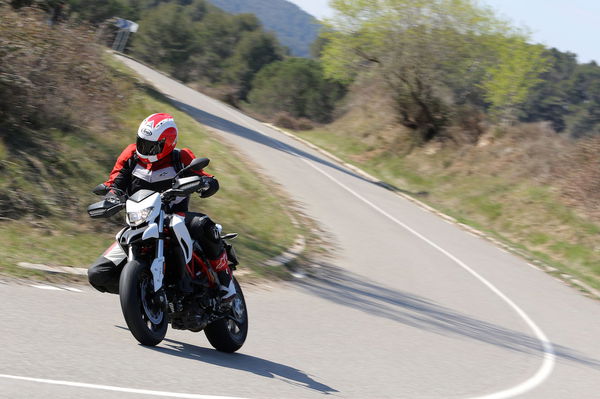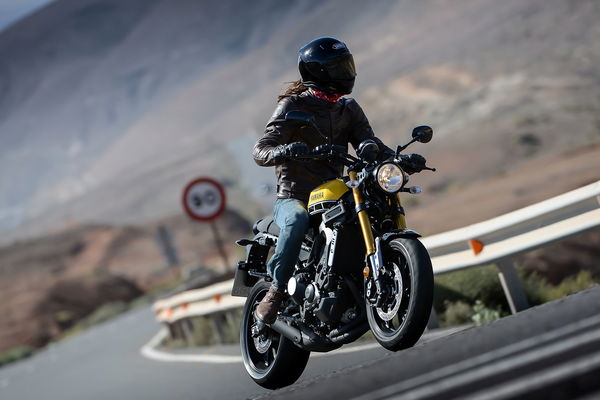First ride: Ducati Hypermotard 939 / SP review
The new Hypermotard 939 might be fun, but it still means business


THE supermoto-style Hypermotard may not be the first bike that springs to mind when the word ‘Ducati’ is mentioned. Images of bikes like the Panigale or hugely popular Multistrada adventure all-rounder are probably far more likely to pop into the grey matter between your ears. But the lean, lightweight, V-twin funster, originally introduced in 2007 as an air-cooled 1100 that's since endured and evolved into 796 and 821cc forms, is still a hugely significant machine for the Bologna marque where it’s seen as key to the culture and spirit of the Italian manufacturer. And, while not a huge seller in the UK, the Hypermotard has proved particularly popular in mountain countries such as Austria and Switzerland, often as a second bike for Sunday fun. It must be all those hairpins.
Because of that significance and partly due to the new Euro 4 regulations, Ducati has given it a significant makeover for 2016 – and when I say ‘it’, what I mean is not just one bike, but the whole Hypermotard family, which now comprises three machines: the standard Hypermotard; the specced up Hypermotard SP complete with Ohlins multi-adjustable suspension, lightweight wheels and so on, plus a ‘touring’ version (although, if you’re anything like me, a touring version of a supermoto is still something of an anathema – let’s just say ‘more practical version’ instead) - the Hyperstrada.
The changes are essentially two-fold and feature across the threesome: an uprated and enlarged version of the previous 821cc Testastretta 11º ‘L-twin’ engine, plus the addition of a few new utilitarian features, a gear indicator for example.
With the Hypermotard’s tubular steel trellis rolling chassis, cycle parts and bodywork remaining unchanged, the biggest material difference then is to the engine, and have been intended not just to adhere to the new Euro 4 regulations, but to give it a significant performance boost as well. To achieve that, the bore has been increased to take the capacity up from 821 to 939cc via new pistons, rods, crank and head design. Crucially, however, the valve size is unaltered which has the effect of improving combustion efficiency which in turn boosts midrange torque. Other changes to the drivetrain include a new, slightly longer exhaust and the addition of a new oil cooler. The overall result, Ducati claims, is an 18% boost in midrange torque while, less importantly, peak power is also up a touch (by 3%) to 114.5hp at 9,000rpm.
Elsewhere there are subtler changes, namely new LED indicators mounted into the supermoto-style hand guards, plus, in response to feedback from owners, the addition of a gear indicator in the LCD digital console. Apart from a few colour changes (the standard bike will be available in red or white with a red frame, the SP in special red/white livery with a red frame while the Hyperstrada comes in red or white with a grey frame) that’s it. But then, there wasn’t that much wrong with the old one.
As it’s the most popular of the three in the UK (not to mention being the core model upon which the other two are based), the standard Hypermotard 939 is the one we rode first in the mountains near Montserrat, Barcelona, Spain.
Being so similar to the old model there’s little to visually differentiate the 939 from the old 821, only the new oil cooler, LED indicators (if you know what you’re looking for) and the logos and badging. From the fairly tall, narrow saddle, it’s all fairly familiar, too: the MX-style seat and wide flat bars give a riding position that’s pure supermoto. You’re upright and exposed and the view ahead is over a small-ish tank and a familiar Ducati LCD digital display which, yes, now includes a gear indicator. It’s tall, stumpy and aggressive.
Thumb the Ducati twin into life and that’s familiar, too. The rumble from underneath is the same as any number of Bologna’s wares such as the Monster, Multistrada or Streetfighter. The ancillaries are familiar too: the minimalist switchgear, Hypermotard-defining, off-road inspired hand guards, small and virtually useless mirrors, and that ultra-stumpy front end which gives the impression that you’re so near the front of the machine you could almost fall into the front wheel. Minimalist, supermoto-style aggression, that’s what the Hypermotard is all about.
But if little of that’s truly new, the immense extra midrange drive from the enlarged motor is. Within a few hundred yards I was aware of a big difference: easy, hugely meaty urge from 5,000 to 7,000rpm (and further if you wish, though there’s not much point on the road); enough to easily hoik the front if it takes your fancy or, more practically, to leap into overtakes, dart through traffic with ease or catapult out of hairpins.
As before, three riding modes are available, all easily selected via the indicator cancel button which interfaces with the LCD display. Sport gives the full 113bhp and sharpest throttle response with ABS and traction control settings to suit. Touring is still 114.5hp but with a softer throttle response (and softer traction/ABS settings) and Urban knocks peak power down to 76hp with the delivery, throttle response etc all softened off further to suit, too. In truth, Touring is the best compromise for most occasions. Sport is so sharp yet so fluffy low down that it only makes sense if you’re on a hardcore cross-country thrash while Urban is so emasculated (albeit with a sweetly responsive delivery right across the rev range), that it only makes sense in the rain, winter or traffic.
Either way, though, the engine is the ‘given’, the motive source, the means to bounce you from corner to corner and hairpin to hairpin. It’s just that now, with that extra grunt, it does it better than ever with fewer gear changes required. Instead, as it has always been with the Hypermotard, it’s all about the handling, the attitude, the aggression. The supermoto stance and wide bars makes the steering light and twitchy but it also means, on these shiny, dusty mountain roads, I had to tip-toe round bends slightly, preferring instead to gas it hard on the exits and feel that fat back tyre bite and squirm.











